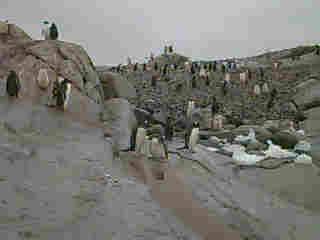
|
|
13 February, 1998
Gould-en Greetings!
Today was a great one. We slowly made our way up the peninsula to Anvers
Island. What is at Anvers Island? Palmer Station is there! We are
off-loading some scientists and their workers to do further research in
Antarctica until April. Also some of the scientists who do studies down
here frequently leave excess supplies here so they do not have to drag them
back and forth between laboratories. Before we leave, a few researchers who
have been down here awhile will come aboard and sail back to Punta Arenas,
Chili with us.
The ship is also helping Palmer Station refuel their stores of diesel fuel
so they will have power and fuel for their heavy machinery. From the
Gould's storage tank, a huge black hose runs up a hill to the bottom of the
storage tank. On hand are oil-absorbent "socks" to catch any fuel that
might happen to leak. Every precaution is taken to ensure a safe transfer
from the vessel to the tank. I am told that we are delivering almost
62,000 gallons!
Tomorrow will be time to pack up those things that are to stay at Palmer
and load on the material from Palmer that needs to go home with the leaving
crew. It will also be a time to explore around the Palmer Station site.
Of course, if one goes outside of a small, well defined area, a sign-out
list must be filled in and perhaps a safety review given. It is not like
walking down to the local park. I've heard about an ice cave that one can
access by zodiac. There is a possibility of getting to do that. If no one
is available to take me to the ice cave, a glacier trail that can be hiked
lies directly behind Palmer Station. It is necessary to follow on the
trail only to avoid crevasses that have been covered with a light crust of
snow, but could swallow a person just as well as an open crevasse.
Glaciers on this island are not one or two feet of ice. They are hundreds
of feet deep. Deep cracks form in this river of ice and a person could
slip into one of these cracks and fall a hundred feet or so. Unfortunately,
once a person has fallen, it is very difficult to save them. Ice is very
hard to fall against and the cracks are not straight. They zigzag down
preventing would-be rescuers from dropping a rope so the person could be
hauled out if they survived the fall. On top of that, these crevasses are
likely to shift at any time making it too risky to send someone down to
help. So, it is very advisable to stay on the trail. I've heard that the
view from the top is awesome, though, and well worth the task of climbing
to the top -- following the trail.
My time in Antarctica is rapidly running out. The ship will be leaving
Palmer Station on Sunday afternoon. We will arrive in Punta Arenas on the
19th of February. Any email inquiries or communications will no longer be
accessible after the 19th of February, so you need to stop sending email to
this ship before the morning of the 19th. I love answering your questions
and communicating with you, so please do not hesitate to send those
questions to my school email address. I have a great network of
researchers from whom I can get answers. It is not a burden, but a chosen
task. Thank you all for the neat questions so far.
My school email address is: bdaw@flash.net
Warm regards,
Mrs. D

Contact the TEA in the field at
.
If you cannot connect through your browser, copy the
TEA's e-mail address in the "To:" line of
your favorite e-mail package.
|
